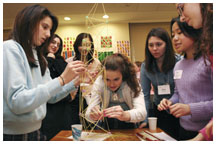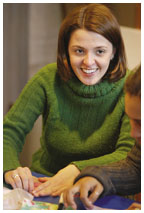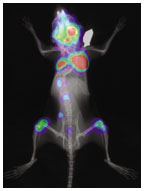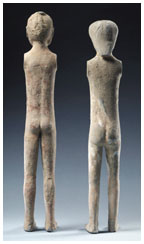Have an opinion about this issue of PAW? Please take a minute to click here and fill out our online questionnaire. It’s an easy way to let the editors know what you like and dislike, and how you think PAW might do better. (All responses will be kept anonymous.) |
March 9, 2005: Notebook
Princeton joins the debate over women in science
The 2003 report: Key findings and results
Making Waves inspires town/gown tsunami relief
Princeton joins the debate over women in science
Leona Qi (third from left), a grad student in electrical engineering, and Gina Monaco ’06 (third from right), a chemical engineering major, help lead a program to spark engineering interest in high school girls in New York last month. (John Jameson ’04) |
Much-publicized remarks by Harvard President Lawrence Summers, who suggested in January that differences of “intrinsic aptitude” between the genders may prevent women scientists from succeeding in academia, sparked impassioned reactions from women faculty at Princeton.
At a faculty meeting Feb. 7, President Shirley Tilghman said that the “ground at Princeton is extremely fertile for talented women who want to be scientists, mathematicians, and engineers,” adding that Princeton was prepared to be an “Ellis Island” for women scientists. Later, she joined with the presidents of Stanford and MIT to issue a statement on the importance of recruiting women.
The controversy promises to add fuel to efforts to recruit women academics, including proposals in a 2003 task force report on women in science and engineering at Princeton. (For an update, see the story on the next page.)
In October 2004, women made up 13.4 percent of senior faculty members in the natural sciences and engineering at Princeton, up from 6 percent in 1992. The number of all women faculty in those areas increased from 8.4 percent to 15.9 percent.
“The good news was that participation of women has been steadily increasing at Princeton,” Tilghman said in an interview. But she added that the data showed “cause for concern” in the hiring of junior faculty women, “which hit a plateau in the 1990s.”
In contrast, women made gains in tenured positions. During 2000—2001, women held 81 tenured faculty positions across all departments, or 17 percent of the total. By October 2004, the number of senior faculty women increased to 103, or roughly 20 percent of tenured faculty.
During the four years that ended in June, Princeton filled 60 tenured faculty positions through outside hires; 11, or 18.3 percent, were women. Of the 93 junior faculty hired, 28, or 30 percent, were women. (The number of tenured positions filled by internal promotions was not available by PAW’s deadline.)
“The task force focused on the importance of giving women opportunities,” Tilghman said. “I think that’s all it takes — women compete perfectly well.”
Asked about the impact of the report, task force chairwoman Virginia Zakian said she is “disappointed that the public response [by the University] has not been more specific.” She applauded the appointment of psychology professor Joan Girgus as special assistant to the dean of the faculty, charged in Tilghman’s words with “monitoring our progress ... she is a signal of unrelenting vigilance.”
Zakian said that Girgus “has been terrific,” especially in working with new hires in resolving questions about spousal jobs, housing, and schools. Zakian added, however, that “many things were proposed” by the task force, “and if there’s been movement, I don’t know about it.”
The University did implement a suggestion by Girgus last fall to help faculty with children travel on professional business. According to Dean of the Faculty David Dobkin, Princeton will pay up to $500 a year to hire someone to stay home with children or to pay someone to travel with the faculty member and care for the children.
But other steps will take longer, Girgus said, adding, “The task force understood there are things we could work on for years.”
Increasing numbers of women are pursuing their doctorates in scientific fields — in molecular biology, women are receiving close to half of all Ph.Ds — but relatively few are seeking assistant professor positions at research universities like Princeton. “Even in a field that’s doing the very best, there is still a roadblock at the postdoc level,” Tilghman said.
The reason for this drop-off? “It’s my own intuitive sense that it is largely the child-rearing issue,” she said, conceding that for some young scientists, the career path at research universities like Princeton “just looks too difficult to combine a family with a career.” But Tilghman, who raised two young children as a single mother while working as a young professor, said many women are doing it successfully.
“The process to tenure is stressful,” Zakian said, especially because research work in science and engineering fields typically requires intensive lab work. “The fact that it coincides with child-bearing years makes it more difficult.”
Julia Chen is president of Graduate Women in Science and Engineering, a group of graduate students and faculty that provides support and social networking. A second-year grad student in computer engineering, she said Princeton has done “a phenomenal job” in supporting women in science and engineering.
But Chen said her “inclination” at this point is for a career in industry. A primary reason is her desire for a family. Other female grad students are choosing either to defer having children, or not to pursue tenure-track positions at top-tier research universities. “There’s no good answer to the question of balancing work and family,” Chen said.
Harvard President Summers theorized that married men are much more likely than married women to work 80 hours a week to secure “high-powered” positions. Emily Carter, professor of mechanical and aerospace engineering, responded in a statement that women want what most men have, “which is to not have to choose between family and career. ... But the current culture of round-the-clock science does not make it possible to do both without enormous sacrifice.” As a result, she said, young women are “voting with their feet.”
The number of tenured women faculty is changing “on a glacial time scale,” Carter said. With administrators like Tilghman and Maria Klawe, the dean of the School of Engineering and Applied Sciences, Princeton is “extremely welcoming” to women, Carter said. But she added that “several of the really basic issues have not been dealt with adequately,” citing the need for enough on-site child-care facilities as an example. Carter also supported Tilghman’s position that in making tenure decisions, there should be more emphasis on quality and originality, as opposed to mere quantity of work produced.
Klawe said women can successfully balance their careers and their family – especially if they have a supportive spouse, dependable child care, and flexible hours. A “rash of babies” born to SEAS faculty shows that assistant professors are working to do just that.
Li-Shiuan Peh is one of them. Peh, an assistant professor of electrical engineering whose son Roy was born in September, said that while she knows “quite a few women” who decided to defer having children until after the tenure process is completed, she could not wait that long. “My feeling is I’ll be too old,” she said. “I love my job, but it’s a job. It’s not ideal, but having a baby shouldn’t be affected by your job.”
Peh does not plan to take the option of adding an extra year to her tenure clock, “partly because I had some key publications, and partly because I’m kind of impatient. ... There’s no way people will let you have a year,” she said. “They don’t expect you to drop out of sight. ... They expect you to handle it.”
Mona Singh, an assistant professor of computer science whose son Akash
was born in December 2003, said the University’s workload relief
(which offers primary caregivers a semester off from teaching and departmental
work after a child’s birth or adoption) and tenure-extension policies
“help out a lot to keep your head above water.” “My
career and my family both take top priority. If you’re happy personally,
you will do better in your work,” Singh said. “The time is
never perfect; you do what’s best for you and your family.”
![]()
By W.R.O.
PAW ONLINE: Click here for the full text of statements reacting to Harvard President Larry Summers’ comments by:
— Engineering professor Emily Carter.
— Six female engineering grad students.

The 2003 report: Key findings and results
In May 2003, Princeton’s Task Force on the Status of Women Faculty in the Natural Sciences and Engineering issued its findings. (A report on women in the humanities and social sciences is expected to be released in the spring.) Here’s an update:
Proposal: Designate a senior faculty member as special assistant to the dean of the faculty, to provide a continuing focus on gender equity issues. Response: Psychology professor Joan Girgus was appointed to this half-time position in 2003.
Proposal: Establish a $10 million fund to hire and retain women in science and engineering; use the Target of Opportunity program, which provides supplemental funds for faculty hires, to recruit women in science and engineering. Response: “Rather than create a fund, the philosophy is to make available whatever funds are needed,” Girgus said. Dean of the Faculty David Dobkin said one of the goals of the Target of Opportunity program is to hire women in fields in which they are underrepresented.
Proposal: Provide sufficient affordable child care. Response: The University is awaiting the results of a consultant’s study on how best to meet day-care needs, according to Girgus. Tilghman described improving access to child care as “very high” on her agenda, saying it must be “on-site and flexible. ... It can’t be 9 to 5, it can’t take off on snow days, it can’t take summers off.”
Proposal: Automatically extend the time to tenure by a year for junior faculty who have new children, and study whether Princeton’s tenure clock should be lengthened for all junior faculty. Response: Tenure will be reviewed — “if it’s not next year, it will be the year after. We want to go into the process well prepared,” said Dobkin. Tilghman supports the idea of adding a year to the tenure process for all junior faculty with new children, with the option of early tenure review.
Proposal: Provide professional mentoring for all junior
faculty. Response: This is expected to be discussed
at a spring meeting of chairmen of departments and programs. ![]()

Meridel Bulle ’05, right, a student coordinator for Making Waves (www.princeton.edu/makingwaves), a collaboration of campus and community groups that is folding origami waves in remembrance of the victims of December’s South Asian tsunami. The group aims to raise $150,000 for post-tsunami reconstruction. (photographs by Frank Wojciechowski)
|
Making Waves inspires town/gown tsunami relief
On the campus and beyond, the Princeton community is learning how to fold. Using everything from origami paper to old magazines, volunteers are making hand-sized geometric waves to honor and support the victims of December’s tsunami in South Asia. The collection of University and community organizations, called Making Waves, aims to fold 150,000 waves by April 23, and raise a dollar for each wave to donate to CARE USA’s reconstruction efforts.
The $150,000 target is ambitious by design, admitted Meridel Bulle ’05, one of the project’s student coordinators. (Princeton Tsunami Relief, a student fund-raising group, collected $17,500 in a six-week period starting in January.)
But with more than two months to fold and thousands of potential helpers in neighboring towns, Making Waves is making progress. By mid-February, a week after the project began, folding events had been scheduled at Frist Campus Center, the Cotsen Children’s Library at Firestone, the Princeton Public Library, and at off-campus sites in Princeton and West Windsor. “It’s a chance to be involved in a different way,” Bulle said, “and be part of your community, too.”
Folding waves has been particularly popular for children, who provided the inspiration for the project. At a Young Artisans Workshop at Cotsen Children’s Library in January, twin middle-schoolers Jennifer and Megan Kao of West Windsor were teaching children to fold origami when a younger child asked them for help folding a wave. The exchange reminded the library staff of the story of Sadako Sasaki, memorialized in the children’s book Sadako and the Thousand Paper Cranes. Sadako was a toddler in Japan when the atomic bomb hit Hiroshima, and she became ill with leukemia as a child. Inspired by a Japanese legend, she tried to fold 1,000 paper cranes to restore her health. Sadako died, but the folding of origami cranes came to represent hope and compassion.
“I think it’s exciting that the genesis of the project came
from kids,” said Bonnie Bernstein, the community outreach coordinator
at Cotsen. “It was not just a bunch of organizers putting their
heads together and trying to raise money for tsunami relief.” ![]()
By B.T.

“For 10 years I used to lie awake at night and think about who would come free me. … I thought about those in my position and promised that some day I would do something for them. … My people and 27 million people around the world are still slaves and still lie awake still counting on you and me to go free them.”
Francis Bok, a former slave in his native Sudan, describing his 10 years
in captivity and his journey to freedom in America. An anti-slavery activist,
Bok spoke at Princeton Feb. 8. He was the first former slave to testify
before the Senate Committee on Foreign Relations in its hearings on Sudan.![]()

Yibin Kang (courtesy Yibin Kang)
Modified bioluminescent cancer cells enable Kang to monitor metastatic tumors in living mice. (courtesy Yibin Kang) |
Breaking
ground: molecular biology
Tracking how cancer spreads
Cancer is the leading killer of Americans under age 85, and survival rates for most forms of the disease are significantly lower when the cancer cells metastasize, or spread from the primary tumor to other areas of the body. For researchers like Yibin Kang, an assistant professor of molecular biology, deciphering the biology behind metastasis is a major challenge. But with help from advanced technology and a background in genomics, Kang is working on new ways to understand and prevent the spread of cancer.
Each form of cancer has a distinct pattern of metastasis, Kang says. Breast cancer commonly spreads to bones, lungs, lymph nodes, and the brain, for example, while colorectal cancer is most likely to spread to the liver. In Kang’s lab, researchers observe the process in real time, using living mice. The mice are injected with cancer cells that contain luciferase, the gene that makes fireflies glow. In the weeks and months after the cells are distributed through the bloodstream, they attack specific sites of the body and form tumors. Using a state-of-the-art machine that detects bioluminescence, Kang tracks a visible record of the location and size of the tumors to get a more precise idea of where and how metastasis occurs.
In Kang’s images of the mice, tumors are easy to see with minimal magnification, but the mechanisms behind metastasis operate on a much smaller scale, in the genes of cancer cells. Many researchers analyze tumors to search for a specific gene that is responsible for the way a given cancer spreads. With about 30,000 genes in the human genome, the one-gene approach seems tedious at best. “It’s also a biased approach,” Kang says, “because everybody wants to claim that their gene is the ‘magic bullet.’ ”
Kang eliminates that bias by using a DNA microarray, which detects all of the genes functioning in a given cancer cell. The microarray identifies several genes that may cause metastasis, and from that list, Kang conducts individual experiments to identify the real culprits. Finding out which genes are expressed in metastasis could lead to targeted, personalized cancer therapy that inhibits those genes, and developing a genetic profile of a patient’s cancerous tissue eventually may give doctors an idea of where metastasis is likely to occur, allowing for preventive measures to protect susceptible organs.
While new technology is important in Kang’s research, the foundation for his work comes from a British scientist named Stephen Paget, who studied cancer in the late 1800s. Comparing cancer cells to seeds and human organs to soil, Paget searched for a biological reason why certain seeds only seemed to grow in certain soils. More than a century later, Kang says he is trying to find “a molecular explanation for the seed and soil hypothesis” with the help of 21st-century techniques.
“We’re basically standing on the shoulders of giants,”
Kang says. “The tools have just become available. The challenge
is to master all of those skills and apply them to answer these age-old
questions.” ![]()
By B.T.

(PAUM) |
A FRESH LOOK at an ancient Chinese burial site is offered by the University Art Museum in the exhibition “Recarving China’s Past: Art, Archaeology, and Architecture of the Wu Family Shrines,” which runs through June 26. Inscriptions and pictorial carvings from a family cemetery complex have been key to understanding one of ancient China’s richest cultural eras. The exhibition includes the museum’s set of rare, 19th-century rubbings, computer-generated models, and sculptures, bronzes, lacquer, ceramics, glass, and jade artifacts from the Han dynasty. The museum is open to the public without charge Tuesday through Saturday from 10 a.m. to 5 p.m. and on Sunday from 1 to 5 p.m. It is closed Mondays.
“TWO CHALLENGES IN IRAQ: Sunni Arab Engagement and Balanced Economic Growth” will be the topic of a lecture Wednesday, March 9, at 4:30 p.m. in Bowl 016 of Robertson Hall. The speaker will be Robert J. Silverman ’80 *82, deputy director of the State Department’s Office of Northern Gulf Affairs (Iraq and Iran).
THE DIRECTOR OF THE EVANGELICAL STUDIES PROJECT will speak on “Evangelicals and American Politics: Assessing the Past, Scouting the Future” Thursday, March 10. The talk by Michael Cromartie, who is also vice president of the Ethics and Public Policy Center in Washington, D.C., will begin at 4:30 p.m. in Bowl 016 of Robertson Hall. The talk is part of the Crossroads of Religion and Politics Lecture Series.
KAYHAN IRANI will present her one-woman show, “We’ve Come Undone,” Sunday, March 20, at 4 p.m. in Friend Center 101. The performance, described as a series of monologues about political detainees in the United States, is sponsored by the International Center and the Princeton Middle East Society. The show is free and open to the public.
TWO WASHINGTON POST FOREIGN CORRESPONDENTS,
Peter Baker and Susan Glasser, will discuss events in Russia Monday, March
21, in Bowl 016 of Robertson Hall. Their talk, “Kremlin Rising:
Vladimir Putin and the Russian Counter-Revolution,” begins at 4:30
p.m. and is part of the “Journalists Writing the World” series.
It is free and open to the public.
![]()

Professor David Bradford, associate dean of the Woodrow Wilson School, suffered third-degree burns on nearly half of his body after a Christmas tree caught fire in his home in Princeton Feb. 8, borough police said. Bradford was admitted to Temple University Hospital in Philadelphia.
The Royal Swedish Academy of Sciences has chosen Princeton astrophysicists James Gunn and James Peebles *62 to receive the 2005 Crafoord Prize “for contributions toward understanding the large-scale structure of the universe.” They share the award, which includes a $500,000 cash prize, with Martin Rees of Cambridge University. Gunn, the Eugene Higgins Professor of Astronomy, and Peebles, the Albert Einstein Professor of Science emeritus, are both longstanding leaders in understanding the origin, development, and current structure of the universe.
The University ranks eighth in the nation in enrolling National Merit Scholarship winners, with 192 among current freshmen. Harvard topped the list with 312, followed by the Univer-sity of Florida with 259. Twenty-seven minority students recognized as National Achievement Scholars entered Princeton in the fall, compared to 85 at Harvard and 61 at Yale.
Toni Morrison, the Robert F. Goheen Professor in the Humanities, has been named a winner of the 2005 Coretta Scott King Award by the American Library Association for her children’s book, Remember: The Journey to School Integration, published in 2004.
Sean Wilentz, the Dayton-Stockton Professor of History,
came up short in his bid for the Grammy award for best album notes. Wilentz
was nominated for an essay accompanying the CD of a 1964 Bob Dylan concert.
Loren Schoenberg won the Grammy for his liner notes for a collection of
recordings by bandleader and clarinetist Woody Herman. ![]()







